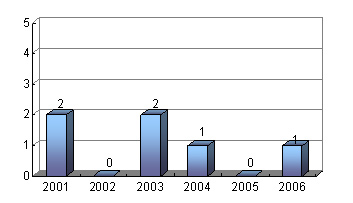| Safety | Hygiene and Health | Employee Development | |||||
| Our Contribution to Society | Case Study: Tsz Ching Estate Green Property Management | ||||||
The provision of affordable quality housing while improving quality of life is about working with the community to foster greater social prosperity and encourage individual achievement. This cooperation results in trust and collaboration, performance and accountability, and careful, attentive services to our tenants and homeowners.
We hope to provide our service responsibly, efficiently and cost-effectively as possible. Safety at construction sites and in our estates remains a major focus of our social programmes. Various measures have also been implemented to help to improve hygiene and the health of our tenants, most notably the inclusion of new health related requirements into the Marking Scheme for Estate Management Enforcement in Public Housing Estates.
The safety of our people and of the general public is of utmost importance to us. We train our people to avoid injury to themselves and others in all phases of their work and we do not tolerate unsafe work practices.
We encourage the involvement of all of our people in safety awareness activities and we give recognition to employees for safety accomplishments. We are committed to fostering the most effective safe practices in all of our work.
By meeting our own high safety standards, we contribute to the well-being of our people, our organisation, and the communities we serve. ![]()
Safety Performance Targets for 2006/07 |
Performance |
Continues to tighten monitoring of contractors with high accident rates. |
Fully met. |
Extend the Pay for Safety, Environmental and Hygiene Scheme to building services subcontracts. |
Fully met. |
Continue to hold regular seminars on audit findings and best practices with the participation of contractors and project teams. |
Fully met. |
Continue to partner with industry stakeholders in participating in territory-wide safety campaigns and publicity |
Fully met. |
Improve the safety of office operations with potential health and safety risks. |
Fully met. |
Continue to provide safety training to staff. |
Fully Met. |
Consider expanding the Silver Card training and requirements to maintenance and improvement work contracts. |
Fully Met |
Issuance of consolidated safety manual and design checklist. |
Substantial progress. |
Keep accident rate to be below 25 accidents per 1 000 workers. |
Fully met. |
Construction Site Safety
Safety has always been a priority for all of our employees, contractors, and tenants in our daily operation. Even as we continue to increase the level of technological sophistication in our operations, the key success factor lies in our care for people.
Housing Department Site Safety Sub-committee
Understanding that safety depends very much on the cooperation of our employees and business partners, we established the Housing Department Site Safety Sub-committee (HDSSSC) with the participation of employees, government departments, contractors' associations, worker unions and other related organisations to foster a greater focus on safety. Tasked with the job of reviewing and advising on site safety management measures on all HA construction and maintenance contracts, the HDSSSC holds meetings with stakeholders at half-yearly intervals to review site safety measures. The first meeting was held in November 2006 with more than 30 participants.
Housing Authority Safety Audit Scheme
This year, we continued to implement the Housing Authority Safety Audit Scheme, developed and operated since 1996, to assess the site safety performance of our contractors in new projects. The auditing system has been reviewed regularly in respect of its coverage and safety standards. Given the steady improvements in safety performance over the years, the safety auditing system has been further upgraded, with the following highlights in 2006/07:
- Expanding the scope of safety audit to cover the safety performance of Building Services Nominated Sub-contracts
- Linking the safety audit performance to payment for site safety items under Pay for Safety, Environment and Hygiene (PSE&H) Scheme, with the score banding for payments according to the level of performance achieved in the safety audit
- Adjusting the scoring under the Serious Accident component of the PSE&H Scheme to take into account the seriousness of accidents. Tenderers who suffered such mishaps in the past have been placed under "quarantine" with the issue critically examined before a contract is awarded
- Increasing the weighting of audit scores in the effectiveness of physical implementation of safety
- More emphasis on high risk or high accident rate activities.

Safety Consideration in Procurement
Management and mitigating risks is vital to project success in the interests of site safety. Competent contractors are those who can excel and sustain continuous improvements in site safety. We have been continuously reviewing and enhancing our measures to secure competent and reliable companies. During the tender evaluation, tenderers past safety records will be taken into account as part of the Performances Scores under the Preferential Tender Award System. For maintenance contracts, good safety record has been incorporated in the selection of tenderers. Contractors with poor safety records would have less chance for tendering our projects.
Performance Assessment Scoring System
In addition, our Performance Assessment Scoring System (PASS) plays an invaluable and systematic role in assessing, monitoring and measuring the effectiveness of our building contractors. At the end of 2006, the average PASS score improved by almost 4% compared to figures at the end of 2002. Site safety assessment under PASS has been further strengthened in 2006/07 through the following additions:
- Incorporate better standards for safe practices on site
- Address safety of temporary electrical installations
- Differentiate Green Card and Silver Card compliance
Site Safety Standards and Monitoring
As a major public sector client, the Housing Authority has taken an active role in upholding site safety standards. We have continuously rolled forward initiatives to motivate contractors to improve their safety performance, develop safe working conditions on site, enhance safety awareness and foster best work practices. We continue to focus on our Site Safety Strategy, first endorsed in 2000, tightening specification requirements and strengthening tender and contractual controls to ensure that safety is maintained to the highest standards at our sites. Our Site Safety Strategy essentially relates to construction works that encompasses 40 initiatives under five focus areas (Please see note).![]()
Environmental, Health and Safety Construction Practices
As Hong Kong's largest property developer, we seek to lead the industry with environmentally friendly, healthy and safe construction practices. We have taken another step forward in this direction with the introduction of 'hard-paved construction' at all our building and piling sites, thus creating a cleaner, safer and more efficient site.
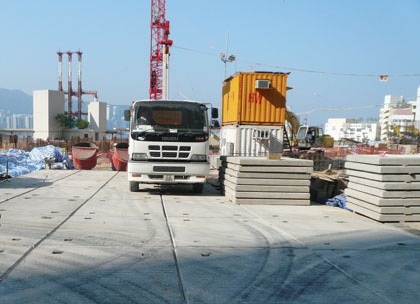 |
|
| Hard Paved Construction at One of Our Construction Sites | |
Our pilot project, exploring the greater use of precast concrete in the building progress proceeded apace in 2006/07. The use of precast concrete also reduces any associated health risk on-site (Please see the Environmental Performance, Noise Section for further details).
Safety Indicators
Our safety indicators demonstrate that our safety initiatives and programmes achieved our annual goals. These measures have helped drive down accident rates significantly. Performance of New Works Contracts has improved from an accident rate of 55.8 per thousand workers in 2001 to 11.5 in 2006 (Please see note). Our figure compares favourably with the overall industry average, where the accident rate per 1 000 workers stands at 64.3 (Labour Department, Hong Kong Government) in 2006.
Despite our safety initiatives, controls and procedures, one fatal accident occurred in a district term maintenance refurbishment contract involving demolition works, in which a section of a partition wall abutting the ceiling fell and struck a worker.
Accidents at Housing Authority Construction Sites
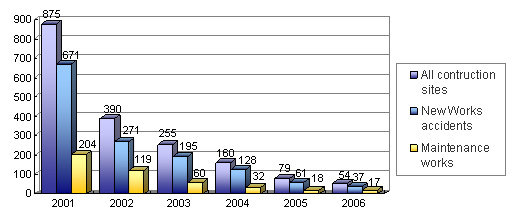
Accident Rate for New Works per 1,000 worker compared to
Local Construction Industry Average
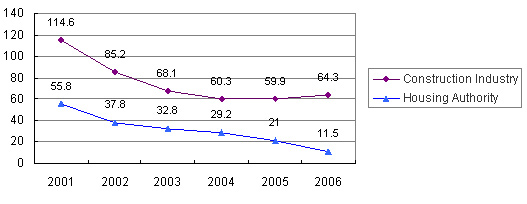
Building Safety, Quality, and Maintenance
Because of the physical nature of many of our services, safety in our estates has always been a significant challenge and a top priority. As such, we have developed and implemented the following policies and programmes in 2006/07 to ensure the health and safety of our tenants.
Estate Improvement Programmes
Supporting the Total Maintenance Scheme and the Comprehensive Structural Investigation Programme, our Estate Improvement Programmes seek to improve the quality of life of our residents with the modernisation and improvement of facilities in our estates. Initiatives range from work carried out for the visually and physically impaired, such as the installation of additional lifts or the modernisation of lifts, better or more energy efficient lighting to the provision of leisure and landscaping facilities.
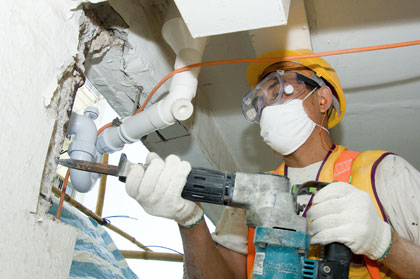 |
|
| Total Maintenance Scheme Repair Activities | |
Redecoration – Maintaining our estates in tip-top condition, the redecoration of 11 estates proceeded smoothly. A new Colour Advisory Review Panel was set up during the year to provide specialist advice on colour schemes, oversee redecoration projects and review customer feedback.
Improved Water Quality – A long-term plumbing programme to replace galvanized iron fresh water pipes with non-ferrous pipes in our existing domestic blocks was launched in 1996/97. During 2006/07, fresh water pipes in 60 blocks were replaced at an investment of HK$96 million. By the end of March 2007, the fresh water pipes in 800 blocks had been replaced.
Water Supply Systems – Continuing the improvements to our water supply systems, 15 pump rooms were renovated in seven estates. To date 278 pump rooms have been renovated under this programme.
Electrical Wiring – In 2006/07, the electrical rewiring programme inside domestic flats was rolled out in nine estates. A total of 7 818 flats were rewired with wiring accessories upgraded to the latest statutory standards and the number of sockets increased to suit tenants' requirements.
Lift Modernization Programmes – These programmes progressed smoothly in Tai Hing, Shek Kip Mei and Wo Che Estates. In total, 33 lifts have been constructed. In response to requests from the public, we are also conducting feasibility studies, looking into the structural aspects as well as tenant needs, to add lifts into various low-rise domestic blocks, which are currently without lift services.![]()
Marking Scheme for Estate Management Enforcement
Our Marking Scheme for Tenancy Enforcement in Public Housing Estates aims to ensure that our tenants behave in a socially responsible manner. The Scheme allots penalty points or a fixed penalty fine for tenant behaviour which causes danger or a nuisance to other residents or is detrimental to our estates. The Scheme has been renamed as 'the Marking Scheme for Estate Management Enforcement in Public Housing Estates'. Three more hygiene-related misdeeds – "causing noise nuisance", "damaging or stealing the Housing Authority's property" and "smoking or carrying a lighted cigarette in enclosed common areas, including public lifts, lift lobbies, corridors and staircases, in a domestic building" – were added to the scheme. The new measures took effect in January 2007. These changes are in place to reflect an increased scope of the scheme to consider health aspects of Public Rental Housing (PRH).
Between the scheme's inception in 2003 and end of March 2007, a total of 5 645 cases relating to 5 431 households have received penalty points. Ten households have accrued 16 or more points under the marking scheme. As a result, nine Notices-to-Quit have been issued and one tenant submitted a Notice-to-Quit himself.
Social Performance Target for period 2006/07 |
Performance |
Continue implementation of the Marking Scheme in all Public Rental Housing (PRH) estates and factories to enhance the living and factory environment respectively. |
Fully met. |
Property Service Agent Management
In order to maintain the property management services provided to PRH by outsourced private management companies, a Property Service Agent (PSA) Review Committee has been established to monitor the PSA performance. This year, the performance scoring system has been reassessed to balance the considerations of the Housing Department staff, the Estate Management Advisory Committees (EMACs) and the tenants. We also implemented a series of regulatory actions to deal with varying levels of underperformance.
Similarly, the performance of service contractors is assessed against a point system with local tenants, Housing Department staff and EMAC members providing separate scores on performance. The resulting score plays a major consideration in decisions on the extension of contracts and in the awarding of tender opportunities for future projects.
As part of the letting strategies for providing greater flexibility for tenants, immense effort has also been invested into redesigning spaces into community centres and services that will benefit the community. (See the Case Study for further details)
![]()
Universal Design and Barrier-free Access
To improve the quality of life of our tenants and meet the diverse needs of our community, since 1998 we have incorporated the principles of barrier-free access into the design of all our projects. Extending this concept into the home, universal design principles have been incorporated into all building common areas and into individual flats since 2004. These design developments facilitate easy access for tenants with special needs (eg the young, the old, and the handicapped). In addition to providing a safe and accessible environment for tenants with special needs, the design developments also help foster a sense of community as they allow existing residents to "age in place" and the physically and visually impaired to live safely and independently within the community.
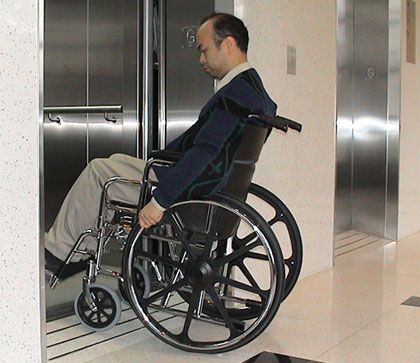 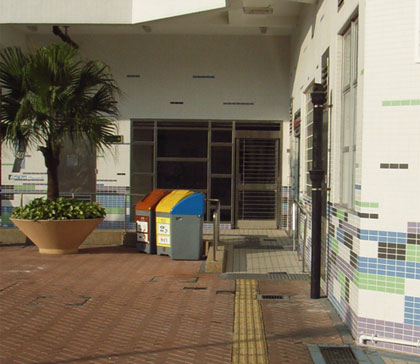 |
|
| Barrier-Free Access Design in Practice | |
Apart from barrier-free access, provisions brought in under this concept also include tactile paths, tactile guide maps at strategic points, audio and visual information, safety features in the home as well as specially designed play areas for children. These are now standard provision in all new estates and a programme is in place for modifications to existing estates to meet the latest standards. We also carry out home modifications for the aged or disabled residents based on advice from occupational therapists and supported of a medical certificate. Improvement works for the visually impaired also commenced in existing estates in early 2006.
Enhancing Fire Safety
Fire safety is a key priority in our activities. As such, we continued to upgrade our fire service installations, especially our fire alarm systems in public housing estates. Damaging or stealing such service installations was included as a misdeed under our Marking Scheme for Estate Management Enforcement in Public Housing Estates from January 2007. ![]()
Hygiene and Health
Our safety and environmental policy also covers hygiene and public health quality. We strongly believe that healthy and secure public housing will promote social cohesion and economic prosperity. More specifically, we have implemented the following measures to improve the hygiene and health of our stakeholders and mitigate the impact from our contractors' operations.
Smoking Restriction
With the implementation of the new anti-smoking laws in early 2007, we have extended the smoking restriction to all common areas, both indoors and outdoors within housing estates except at designated outdoor smoking areas. This is to ensure that such facilities will result in minimal disruption and nuisance to other estate residents. To cater for the need of persistent smokers in housing estates, the Subsidised Housing Committee, also endorsed the setting up of designated outdoor smoking areas in estates in consultation with the Estate Management Advisory Committees ensuring that such facilities will cause minimum disruption and annoyance to non-smoking estate residents.
Drainage Improvements
We developed a new "common W-trap design" in collaboration with the City University of Hong Kong to address the drainage problems associated with dried-up floor traps in the above ground drainage systems, which were identified as a contributory factor in the spread of the Severe Acute Respiratory Syndrome (SARS) virus. The new design has now been implemented in all two new projects and a Technical Guide has been produced to facilitate installation in future new projects.
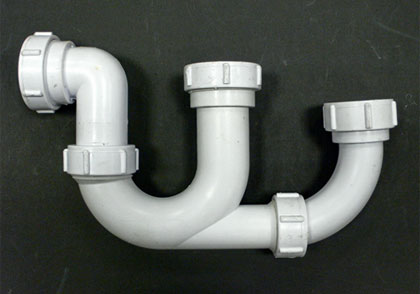 |
|
| The Common W-trap Design to the spread of disease | |
Mosquito Control
Mosquitoes cause a great nuisance to the public, and some species, such as aedes albopictus, pose threats to public health as vectors of diseases like dengue fever. The Government established the Monthly Ovitrap Index (MOI) in 2005, which reflects the territory-wide situation of aedes albopictus. We have long been supporting the Food and Environmental Hygiene Department in preventing the breeding of mosquitoes. Measures for mosquito control included inspections of mosquitoes breeding ‘black spots' to assess the problem in our estates, trimming of overgrown vegetation, clearing of blocked drains and paving of uneven ground in estates to eliminate the potential for breeding of mosquito larvae. Mosquito-catching apparatus have also been placed in strategic locations at PRH estates in high MOI districts.
We have initiated training and public events to promote awareness amongst our staff, contractors and tenants through seminars, posters, inspection checklists, meetings and telephone hotlines to provide information and assistance on the control of mosquito breeding. As a result, the number of convictions for mosquito breeding from our construction sites has been significantly reduced in recent years.
Number of Convictions for Mosquito Breeding from our Construction Sites
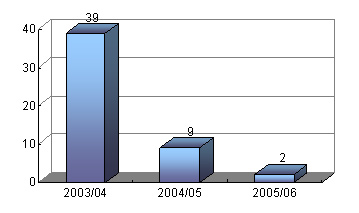
Employee Development
Attracting and retaining a skilled and motivated workforce is essential to our organization. We offer competitive compensation and benefits, invest in the skill development of our people through comprehensive training and development programmes which promote life-long learning opportunities.
Training for Employees and Contractors
Training is the cornerstone of safety in the Housing Authority (HA)'s operations. General safety training courses are regularly organized and self-learning packages are available for all HA staff to familiarize themselves with the current practices and statutory requirements, and to enhance their hands-on skills. In 2006/07, 34 classes were held covering 9 training modules, attended by 660 departmental staff. These included green card refresher courses, courses on safety training for certified workers in confined spaces, safety management in alteration of buildings and risk management in temporary works.
In line with our succession planning, individual-tailored training programmes are offered to staff with high potential for greater responsibilities. Training programmes include leadership skills, interviewing and investigating skills, management development, handling family violence, prevention of suicidal acts, as well as patriotic education programmes. The average training provision assigned for such staff members for 2006/07 was about HK$1 600 per person.
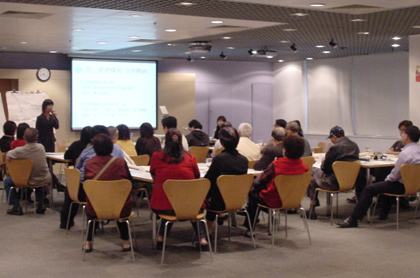 |
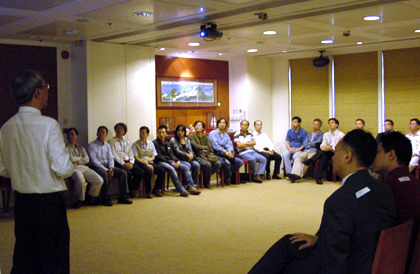 |
In addition, we provide subsidies for our staff to pursue continuing professional education outside of office hours. To inject fresh impetus into our management work, we also arrange overseas training for our staff.
On a general level, our e-learning portal continues to go from strength to strength. During 2006/07, a number of new web-based curses including procurement in estates, cleansing and security contractors, maintenance and inspection of plumbing and drainage systems were developed and uploaded onto our e-learning platform, enabling our staff to gain easy, convenient and 24 hour access to this knowledge sharing experience.
Driving more professional services, we collaborated with the Hong Kong Polytechnic University to run a part-time Certificate Course in Public Housing Agency Management. We sponsor half the course's tuition fees for 475 property officers nominated by Property Sevice Agents (PSAs) to encourage PSA staff to participate in the programme.
Securing Workers' Payment and Rights
On-demand Bond
To empower the HA to make direct payments to workers for outstanding wages in proven cases of default by a contractor or sub-contractor, we extended the requirement for an On-demand Bond in all new work contracts in October 2006. This bond can be used to secure payment of staff wages in arrears by overcoming constraints imposed by the law on insolvency if the contractor or sub-contractor in question proceeds to liquidation or is being wound up.
Corporate Structure and Remuneration Package
Seeking to build a leaner and more dynamic organisation, a target was established to reduce the HA's establishment by 3 500 posts. As a result, 3 471 posts were deleted over a five-year period from 1 October 2002 to 31 March 2007. With the completion of this exercise, no further substantial changes to our establishment are expected.
In 2005, we commissioned a consultant to look into the remuneration package of the HA contract staff. As a result, salaries for our contract staff were revised in line with the consultant's findings and market conditions in 2006/07. Greater flexibility in staff recruitment and retention was also introduced to deal with situations where there is high demand for a particular skill in the market. We are also working on a performance-based salary progression scheme for our contract staff which will both motivate and reward staff for service excellence.
Protecting the Rights of Non-skilled Workers
We have introduced stringent measures into services contracts to protect the wages, working hours and the rights of non-skilled workers. We are taking a hard line in demonstrating our determination in this direction. From 1 May 2006 onwards, a service contractor convicted under the relevant government ordinances or who has received three demerit points in a service contract will have his or her service contract terminated immediately. Additionally, a contractor who has such a conviction or a total of three demerit points from one or more government departments over a rolling period of three years will be removed from our list of approved contractors for a period of up to five years.
Our Central Monitoring Team also took a proactive role, conducting investigations into possible instances of non-skilled worker exploitation. During the year, 2 183 employment records pertaining to 53 cleaning and security service contracts in 37 estates were checked and 1 563 non-skilled workers were interviewed in the detection and prevention of any such exploitation. We also helped non-skilled workers to learn about their rights and the contract conditions of their employment through the provision of printed information, interviews, seminars and briefings as well as information hotline. We hope that these stringent measures will send out clear messages that we will not tolerate exploitative actions of any kind and that quality and sustainable services are only possible with an equal commitment to social responsibility.
Apart from HA's direct employees, the nature of our service also involves a large number of contractors. It is our responsibility to protect the welfare of the people who are employed both directly and indirectly by the HA. Previously, three HA building sites have experienced contractual problems including the failure of the contractors to meet contractual obligations and reports that their workers were not being paid. Last year we have regained these sites and after intensive negotiations, the projects were re-awarded in May and June 2006.
In order to protect the workers under the initial contracts, the new contractors were required to employ at least 80% of the original subcontractors. Benefiting from workers with extensive knowledge with the projects and the improved site conditions, the construction work proceeded smoothly. The resulting progress has been extremely satisfactory with all three projects well on track.
Working Group on Monitoring Wage Payment to Workers
As a result of our activities with regard to the termination and re-tendering of three construction contracts in 2005/06 and the intensive negotiations held at that time with the Labour Department, the Environment, Transport and Works Bureau as well as industry representatives, all new building and demolition contracts tendered from May 2006 onwards include a number of wage monitoring measures. Measures such as the keeping of proper worker attendance and payment records, the provision of a Labour Relations Officer on site, as well direct payment to workers in case of default have helped protect the interests of workers and provide them with a more secure working environment.
The Working Group on Monitoring Wage Payment to Workers was established by the HA in December 2006 to secure wage payments to workers. The group consists of workers, employers and representatives of government departments.
Our Contribution To Society
Since the establishment of the Housng Authority (HA), we have taken the community's needs as our priority. We pay particular attention to those in need and aim to provide them with a comfortable and good quality living environment. We do so by carefully managing and allocating available housing resources, identifying and shaping policies for those with imminent needs. We have extended our efforts to conserving housing heritage and revitalising assets for the enjoyment of not only our tenants, but also for the general public.
Housing Management and Allocation
During 2006/07, the HA continued to provide subsidised rental housing to those who cannot afford to rent accommodations in the private market. It has also assisted the Government in maintaining the Average Waiting Time for Public Rental Housing (PRH) for the last four years. The overall average waiting time for general PRH applicants and elderly one-person applicants, was maintained well within the Government's pledge of three years and two years, respectively.
Trend of Average Waiting Time for Public Rental Housing Applicants (years)
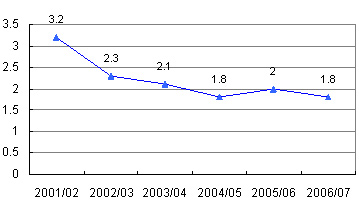
To ensure housing resources are efficiently allocated, we have effectively utilised the Tenancy Management Module of our Estate Management and Maintenance System. In addition, our District Tenancy Management Office and a special unit, the Public Housing Resources Management (PHRM) Sub-section are working closely together to demonstrate excellent progress in liaising with other government departments (eg the Police, the Customs and Excise Department, etc.) to ensure appropriate housing resources allocation and prevent the abuse of such resources.
Some of our major achievements during 2006/07 include the following:
- PHRM carried out in-depth investigations into about 5 500 suspected tenancy abuse cases and supported regional management in checking into suspected cases of housing abuse. As a result of these investigations and activities, 9 129 PRH units were recovered for re-allocation to waiting applicants;
- We conducted an Express Flat Allocation Scheme in the latter half of 2006 to allow quicker access to PRH especially for those wishing to be rehoused promptly. The Scheme has not only increased the efficiency of housing allocation but also improved the letting rate of our less popular flats. The results were extremely encouraging with the successful letting of 3 533 flats to eligible applicants in 2006/07;
- The PHRM conducted stringent checks on some 4 200 cases to determine the eligibility of public housing tenants for subsidised housing according to the Housing Subsidy Policy, the Policy on Safeguarding Rational Allocation of Public Housing Resources and the Grant of New Tenancy and Tenancy Management Policies;
- 18 700 flats were allocated to Waiting List applicants (among which 3 716 elderly households were expedited through various priority schemes), bringing the total number of PRH flats in use to 677 800 by the end of March 2007. A further 18% were living in
380 500 flats under the HA's subsidised home ownership schemes; - 520 overcrowded households were successfully re-housed into larger flats through two Territory-wide Overcrowded Relief exercises. Through the Living Space Improvement Transfer Scheme, first launched in January 2006, 1 254 households were re-housed and 4 551 lettings were made as a result of this special transfer. This programme allows tenants living in a flat area below 7 m2/person to move into a larger home. At the end of March 2007, the number of overcrowded households had dropped to 4 587 or 0.71% of the total PRH homes;
- 545 more affluent tenants, including 241 families who purchased their own homes under subsidized home ownership schemes, returned their PRH flats to us;
- 560 households were relocated and re-housed as a result of the clearance of 390 illegal rooftop structures in single staircase tenement buildings as well as 160 squatter dwellings;
- In November 2006, we endorsed a 2007/08 programme of activities to review policies encouraging adult children and young families to live with their elderly parents or relatives, together with existing priority schemes such as the Elderly Persons Priority Scheme and Special Scheme for Families with Elderly Persons. These initiatives, which can advance PRH allocations by a maximum of three years, aim to foster the well-being and caring the elderly by encouraging families to live with, and take care of, their elderly relatives;
- In December 2006, we introduced the Accelerated Refurbishment-On-Demand process to speed up the reletting and refurbishment of vacant flats. Prospective tenants, who opt for the Vacant Flat Refurbishment Allowance under this scheme, will have their new homes handed over within 14 days of their acceptance of the flat. This initiative has shortened the re-letting period significantly, which falls from 57 days to 34 days on average;
- Our Comprehensive Redevelopment Programme (CRP) to clear a total of 566 old housing blocks is also proceeding on schedule. The CRP is nearing completion with 550 blocks or 97.2% of the total number being cleared by the end of 2006/07. The programme aims to provide a significantly improved living environment for tenants; and
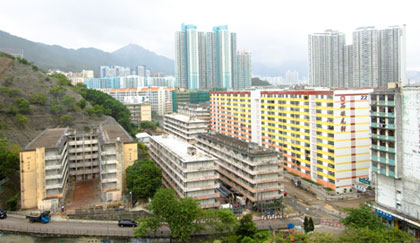 |
|
| Comprehensive Redevelopment Programme clearing old housing bocks | |
- The use of Housing for Senior Citizens (HSC), an earlier type of housing with shared facilities built for the elderly, has been optimised by converting surplus units into normal PRH and thus increasing the available PRH stock for allocation to waiting-list applicants. To ensure the smooth implementation of the HSC conversion programmes in the right pace, about 500 of these units will be converted into normal PRH flats every year.

Convenient Payment Method
Making it easier for tenants to pay their rents and in a bid to reduce rent arrears, our Alternative Counter Collection Channel came into service in March 2007 to facilitate more convenient rent payment by tenants. The service enables our PRH tenants to pay their rents at more than 760 convenience stores throughout Hong Kong. Hand-in-hand with this service, a Rent Enquiry Hotline, providing information on a tenant's current payment status and payment history for the past six months, was also opened. Additionally, a pilot Auto-dialling Rent Reminder was rolled out in 28 estates in March 2007. The service reminds tenants who have payments outstanding through either a short message service or a recorded message, to settle their rents promptly.
A Direct Rent Payment arrangement with the Social Welfare Department has been implemented in mid-2007. Under this scheme, rental payments can be made directly to the HA for tenants receiving Comprehensive Social Security Assistance.
Making Use of Public Spaces
To make the best use of public spaces, action has been taken to redesign spaces into community facilities for services that will benefit the community.
One such example is the letting of space to non-profit-making organisations under the "Enhancing Self-Reliance through District Partnership Programme" established by the Home Affairs Department. Under this initiative, non-profit-making organisations are able to get funding from the scheme to assist in their work to help alleviate district based poverty, assist socially disadvantaged groups and provide support services to needy groups. Leasing applications in Pak Tin, Shek Pai Wan and Kwai Chung Estates are currently being processed.
Other examples of redesigning spaces to meet the needs of the community include the conversion of the top floor of the car park in Tin Heng Estate into an integrated children and youth services centre, the leasing of Chak On Market as a continuing education and community college, the successful conversion of former Chinese restaurants at Kwai Shing West and Wah Fu (II) Estates into residential care homes for the elderly as well as the conversion of part of the car park at Nam Shan Estate into a cultural and arts centre.
Heritage Conservation
With the ever increasing constraint on land availability and therefore heritage conservation opportunities, we are seeking to maintain Hong Kong's housing heritage with conservation programmes. A prime example is the conservation of Mei Ho House at Shek Kip Mei Estate, one of the oldest six-storey resettlement blocks built in the 1950s, which received a Grade I Historical Building designation from the Antiquities Advisory Board in 2005. To make sure that the building will add value to the community rather than becoming a burden, we have invited the Hong Kong Institute of Architects, the Hong Kong Institution of Engineers, the Hong Kong Institute of Planners and the Hong Kong Institute of Surveyors to work with us in organising an idea competition in 2007 to invite the views of the public on the best use of Mei Ho House and its surroundings, with the redevelopment of Shek Kip Mei Estate.
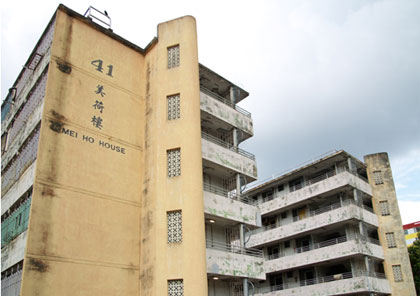 |
|
| Conservation of Mei Ho House | |
Management of Commercial Premises
We continue with the renovation and improvement works at our commercial premises to enhance facilities and ensure that they are on par with other shopping centres in Hong Kong. We also organise various promotional, seasonal and community events to generate greater customer activity and a happy, fun and lively shopping environment for the general public, thus creating value for our tenants and community.
In the management of our commercial facilities, a marking scheme has been put into place to ensure that tenants maintain a clean and healthy environment. In October 2006, an Enhanced Marking Scheme (EMS) was introduced. It covers all commercial tenancies and licences of shops, shop stalls and cooked food stalls, allotting penalty points for various hygiene misdeeds. The offending tenant, on accumulating 16 points, may have his tenancy terminated.
Hand-in-hand with the launch of the EMS, we introduced the Incentive Award Schemes to improve the cleanliness of our shopping malls. Awards are presented on a quarterly basis with effect from October 2006, which include the Best Toilet Management Award as well as a Best Hygiene Award for Food Premises. ![]()
Case Study: Tsz Ching Estate Green Property Management
Tsz Ching Estate was awarded the Grand Prize for the Green Property Management Award (Public Housing) Eco-business award due to the Housing Authority's achievements in enhancing healthy living and a green environment. This was achieved through a holistic approach whereby various estate-based environmental functions and activities were coordinated throughout the year through the Estate Management Advisory Committees, government departments, the police, schools, green groups and our designated contractors to enhance public awareness on environmental protection.
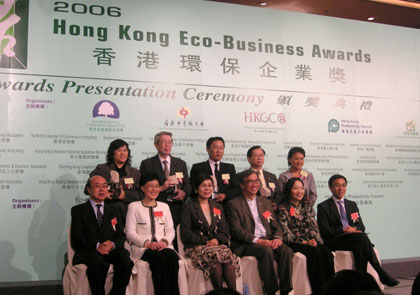 |
|
| Tsz Ching Estate won the Grand Prize for the Green Property Management Award (Public Housing) Eco-business Award | |
Tsz Ching Estate has 8 177 housing units, 11 domestic blocks with a population of some 25 000 people. The estate is built on a sloped area with very scattered planting areas covering 5.5% of the total area. To achieve our green management, we turned the slope railings into a designated natural laundry area, turned unused land to a green corner-cum-orchard, and constructed a giant plastic bottle from collected waste plastic bottles to promote recycling of plastic materials. All activities were successfully launched with the passionate participation of hundreds of residents.
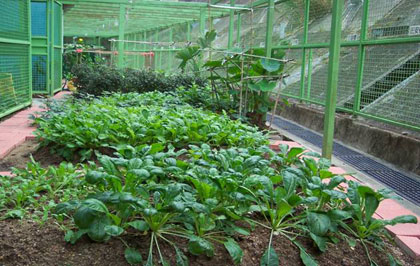 |
|
| Green Corner-cum-Orchard | |
They have a very comprehensive program on at-source separation of domestic waste. Very impressive achievements in recycling were made through voluntary donations and the bi-weekly Green Exchange Counter, resulting in over 257 700 kg of recyclables collected, including paper, plastic, aluminium, clothing; an increase of 18.5% against 2005/06 figures. 151 943 kg of waste electrical appliances, metals and construction waste were also collected; a decrease of 4.5% against 2005/06. Through this programme, the overall domestic waste of Tsz Ching Estate also reduced by 5.7%.
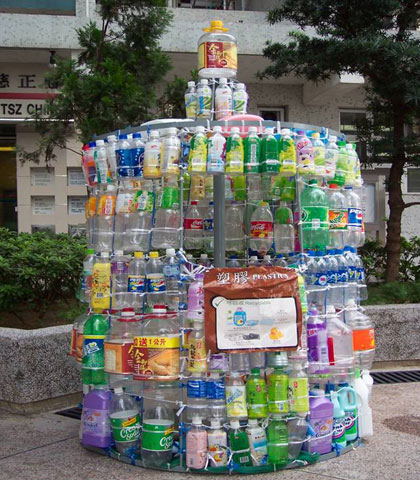 |
|
| A Giant Plastic Bottle Constructed from Collected Waste plastic Bottles to Promote Recycling | |
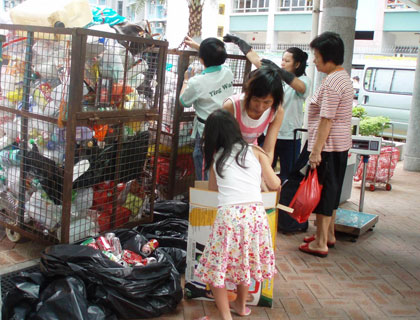 |
|
| Waste Recycling Collection Counter | |
In the area of energy savings, we adopted the Electrical and Mechanical Services Department's Code of Practice for energy efficiency. With the installation of an indoor lighting management device in the corridors of Ching Yi House, electricity consumption was reduced by 30.9%. The installation of photocell sensor control in public areas of domestic blocks further conserved energy by 1.07%. Review of the illumination level and re-circuitry has resulted in an 8% electricity saving. With cooperation from our own staff, the office electricity consumption has been reduced by 8.5%.
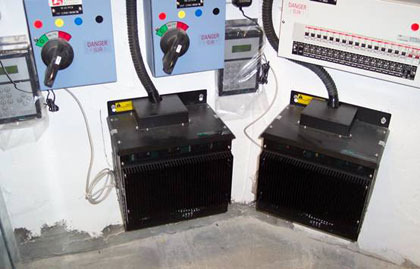 |
|
| Indoor Lighting Management System | |
